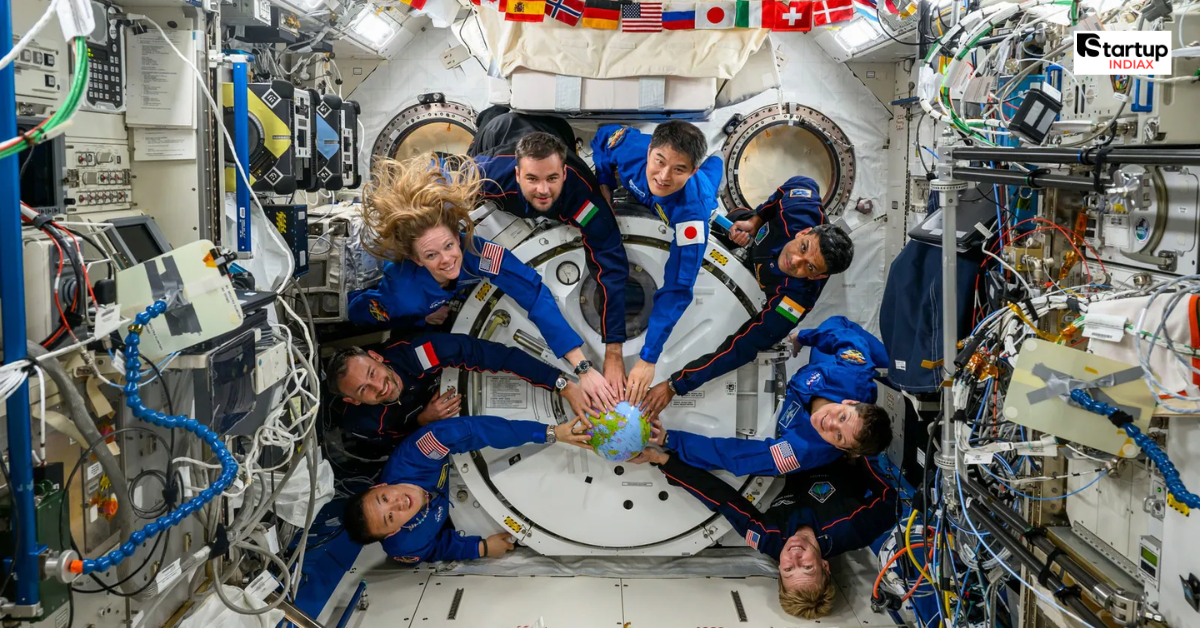Aaj ka Bharat shines brighter than ever, as Group Captain Shubhanshu Shukla’s powerful farewell speech from the International Space Station (ISS) captures the nation’s pride and ambition. His words, “Aaj ka Bharat space se nidar, garv se purn dikhta hai,” reflect India’s bold strides in space exploration. In this article, Startup INDIAX explores Shukla’s inspiring journey, the significance of India’s space program, and how this milestone fuels innovation for entrepreneurs. Learn why this moment matters and how it positions India as a global space leader.
Table of Contents
Why Did Shubhanshu Shukla’s ISS Speech Resonate with Indians?
Group Captain Shubhanshu Shukla’s farewell speech from the ISS in June 2025 stirred emotions across India. His words, delivered in Hindi, carried a sense of national pride and fearless ambition. But why did they strike such a chord? For a nation with a rich history of scientific achievement, Shukla’s message symbolized Aaj ka Bharat—a modern, confident India ready to conquer new frontiers.
Who Is Group Captain Shubhanshu Shukla?
Shubhanshu Shukla, a decorated Indian Air Force officer, became one of India’s first astronauts to reach the ISS as part of Axiom Space’s fourth mission (Axiom-4). A test pilot with over 2,000 hours of flight experience, Shukla was selected by ISRO for his expertise and resilience. His journey from a small town in Uttar Pradesh to the ISS embodies the aspirations of millions. As he said, “Namaskar mere pyare deshwasiyon… kaafi saal baad hum phir wapas antariksh mein pohonch gaye hain,” his pride in carrying the Tiranga on his shoulder resonated deeply.
What Did Shubhanshu Shukla Say in His Farewell Speech?
On July 13, 2025, Shukla delivered his parting words from the ISS: “Aaj ka Bharat space se nidar, garv se purn dikhta hai.” These five powerful words encapsulated India’s fearless spirit and pride in its space achievements. He also expressed gratitude to 140 crore Indians, emphasizing unity and shared success. His speech, shared widely on platforms like X, sparked a wave of patriotism, with users calling it a “moment of pride for every Indian.”
How Does Aaj ka Bharat Reflect India’s Space Ambitions?
Shukla’s words are more than rhetoric—they reflect India’s growing stature in global space exploration. With a space program that balances cost-efficiency and innovation, India is redefining what’s possible.
What Is the Axiom-4 Mission?
The Axiom-4 mission, launched by Axiom Space in collaboration with SpaceX, marked India’s return to human spaceflight. Shukla, one of four astronauts aboard SpaceX’s Dragon spacecraft, spent 14 days on the ISS conducting experiments in microgravity. His excitement was palpable: “It has been a wonderful ride… I’m very confident that the next 14 days are going to be amazing.” This mission, supported by NASA and ISRO, underscores India’s role in international space collaboration.
How Has ISRO Paved the Way for India’s Space Program?
The Indian Space Research Organisation (ISRO) has been the backbone of India’s space journey. From launching 104 satellites in a single mission (2017) to the Chandrayaan-3 lunar landing (2023), ISRO has achieved global acclaim. Its budget of $1.5 billion in 2024 is a fraction of NASA’s $25 billion, yet ISRO delivers results that rival global powers. Shukla’s mission highlights ISRO’s rigorous astronaut training program, which blends technical expertise with mental fortitude. As ISRO’s chief, S. Somanath, noted, “This is just the beginning of India’s human spaceflight era.” Startup INDIAX celebrates ISRO’s role in inspiring startups to innovate in aerospace.
Why Is India’s Presence on the ISS a Milestone?
India’s participation in the ISS is a historic achievement, placing it among an elite group of nations with human spaceflight capabilities. This milestone signals India’s readiness to lead in science and technology.
What Makes India’s Space Program Unique?
Unlike other space programs, India’s approach combines frugality with ambition. ISRO’s Mangalyaan mission (2014) reached Mars for just $74 million—less than the budget of a Hollywood sci-fi film. This efficiency inspires startups to think lean while aiming big. Shukla’s presence on the ISS also showcases India’s ability to collaborate globally while maintaining a distinct identity, as seen in his Hindi speech and the Tiranga on his uniform.
How Does Shukla’s Speech Inspire Young Entrepreneurs?
Shukla’s journey is a masterclass in resilience and vision—qualities every entrepreneur needs. His words, garv se purn dikhta hai, remind startups that pride in their work can fuel innovation. For example, Indian aerospace startups like Skyroot Aerospace and Agnikul Cosmos are developing reusable rockets, inspired by ISRO’s success. Shukla’s speech encourages founders to dream big, collaborate globally, and embrace challenges. As Startup INDIAX notes, his story is a call to action for India’s youth to innovate fearlessly.
What’s Next for India’s Space Journey?
India’s space ambitions are soaring. ISRO’s Gaganyaan mission, set for 2026, aims to send three Indian astronauts into low Earth orbit. Plans for a lunar base by 2040 and a space station by 2035 are in motion. Shukla’s ISS mission is a stepping stone, proving India’s capabilities. For entrepreneurs, this opens doors to opportunities in satellite technology, space tourism, and AI-driven analytics. The global space market, projected to reach $1 trillion by 2030, offers Indian startups a chance to shine.
Conclusion: Join the Conversation with Startup INDIAX
Shubhanshu Shukla’s five powerful words from the ISS—“Aaj ka Bharat space se nidar, garv se purn dikhta hai”—have ignited a spark of pride and possibility. They remind us that India’s space journey is not just about science but about inspiring a generation to dream big. Startup INDIAX invites you to share your thoughts: How does Shukla’s speech inspire your entrepreneurial journey? Comment below, share this story, and explore more inspiring startup stories on our platform!

